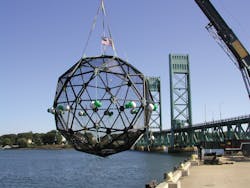Part of the series 2070: A Manufacturing Odyssey
For IndustryWeek’s 50th anniversary issue, thinkers and doers shared their prophecies for manufacturing’s next 50 years. They had big predictions about where tech will take us, how work will change, and how what matters today might be very different in 2070.
But I also want to take stock and gaze ahead in another way: through the lens of a small manufacturer. Riverdale Mills, a Massachusetts manufacturer that commands 85% of the U.S. market in its niche—lobster traps—has a dynamism and rich history that make it a good subject for this exercise.
Riverdale Mills faces similar hurdles as corporations many times their size—tariffs, a soft market, a strong dollar, etc. (Plus, they have their own idiosyncratic hurdles, like when the lobster industry is on forced hiatus during right whale migration.)
Their story is worth telling as part of our anniversary coverage because they’re a microcosm of the challenges and excitement surrounding manufacturing in the past half century, and that yet to come. Riverdale Mills has had its ebbs and flows over the years, but creative thinking, and a thirst for discovery and dialogue, have kept them flourishing.
The Beginnings
James Knott Sr., was a polymath. His mind never rested, not even when he was fishing. A decorated Army veteran and a Harvard College grad, Knott Sr. invented several coatings while running his own manufacturing company, Coatings Engineering Corporation.
Knott Sr. sold CEC in 1975, staying on as president and director. Finding himself with more free time, he took up lobster fishing in Gloucester, Massachusetts. In his excursions along the cape, he saw the struggle of seasoned lobstermen hauling in their wooden lobster traps. The traps rested on the sea floor and were brought up periodically to see if there was a catch. Brightly colored buoys on the water’s surface identified a trap’s owner.
Over time, soaking up brine and seaweed corroded the wood and the netting, and the traps became waterlogged—sometimes weighing up to 120 pounds with all that water and making the lobster-hauling work especially punishing.
Knott Sr. figured there had to be a better way. He knew of a nascent powder-coating technology that hadn’t been commercialized. He started experimenting with it for coated wire mesh on traps—using zinc to galvanize a long roll of welded wire mesh and then coat it with a marine-grade PVC coating.
“He used to take his wire to some of the guys who were building the wooden traps and ask them to staple or nail it to the side of a trap, and to remove the wooden laths that they use,” says his son, Jim Knott Jr. “People started adopting that process and it became quite popular.”
James Sr. enlisted young Jim in the prototyping. “When I was growing up, my father gave my brother money to buy lobster traps,” Jim Jr. recalls. “And my brother went off and bought 10 lobster traps, and he would fish the lobster traps and then sell the lobsters in the neighborhood.
“The next year, I wanted to do the same thing. And he said to me, ‘No, you’re going to make your traps on a wire mesh.’ Which I did, and they weren’t very successful in the beginning.” They refined it, replacing the wire on the “heads” where the lobster enters the trap with traditional twine—and had a winner.
Early fans—lobster fishers in Maine—also liked that the 30-pound wire trap, unlike wood, was not buoyant, staying put on the ocean floor instead of being pushed around by the tide. A new catchphrase was born: “We used to say, ‘It’s lighter on deck and it’s heavier in the water,’” says Jim.
Diamond in the Rough
In 1979, after refining their proprietary Aquamesh coated wire and improving the design, James Sr. purchased an abandoned papermill near Worcester, Massachusetts to begin manufacturing the traps. The mill dated to the 1850s; the structure was originally used for manufacturing scythes and then switched to forging bayonets for the Union Army in the Civil War.
It had seen better centuries. “The fire chief came in and said, ‘If this catches on fire, do you want me to put it out, or do you want me to let it burn?’” Jim Jr. recalls. “We said, ‘Put it out,’ and he said, ‘Good to know because I’d ordered my men to let it burn.’”
Financing was tight—“there was a very clear cash constraint,” says Jim Jr.—so they repurposed as much equipment from the old papermill as they could, turning it into equipment that could plastic-coat wire.
“The equipment didn’t translate, but parts of the equipment translated, such as pumps, controllers and drives and things like that,” says Jim. “And as we became more successful and grew the business, we would obsolete the old equipment and put in more modern equipment that was more reliable, and more repeatable.”
Scaling Up
To keep up with demand, James and Jim began integrating more production into the old mill, including the processes for drawing, galvanizing and welding wire, and looking around for more applications for their product. Oyster trays—wire mesh cages that float on water’s surface as the shellfish grow–were an obvious choice, but demand was low for a good while. “Oysters fell out of favor for probably 50 or 60 years,” says Jim. “And now they’re a very favorable product.” The Knotts’ oyster tray was designed to tumble the shellfish on the surface of the water as they grew to give them a more desirable shape.
The trays were co-developed with a customer, an injection molding company in Canada. The injection molder manufactures the floats to float the Aquamesh growing cages on the ocean surface. “We had to adjust the mesh design a few times and tweak it a little bit,” says Jim. “But I think we’ve got a product that is very well-accepted by the marketplace.”
Diversifying
The Knotts weren’t content to just pump out lobster traps, oysters trays and, later, crab pots for catching crabs. Among other products, they developed a “wire wall” security mesh that “you can’t climb and you can’t cut,” says Jim. For now, most of their customers are in Europe. They recently had a U.S. Special Forces team at Fort Bragg test it. “It took them about 45 minutes to cut through,” says Jim.
They have also branched out into the poultry industry, working closely with Poultry Science researchers at the University of Georgia to produce a tight mesh for chicken platforms so the poults don’t get splinters from wood platforms—greatly reducing foot infections and the use of antibiotics. They work closely with the Lobster Institute at the University of Maine as well and have hired engineering co-ops from nearby Worcester Polytechnic Institute.
And they supply the mesh covering for experimental fish farms called Aquapods—geodesic globes in development as a sustainable alternative to deepsea fishing. The globes are tethered to a vessel and left adrift at sea for weeks or months as a time as the starter fish eat and grow. The mesh contains the fish but lets water in and prevents “biofouling” with algae and barnacles that clog production.
Tackling Tariffs
Amid all the partnering and innovating, the tariffs hit Riverdale Mills hard. Riverdale Mills imports thousands of tons of steel a year, says Jim. “Seventy percent of that was coming from Canada, 14% from Brazil and 10% from Korea. So that hurt us very badly.”
Any wire they bought from overseas had a 25% steel and aluminum tariff plus a 15% consumer goods tariff. “So the raw materials were coming in with a 40% total tariff.” They applied for tariff exemptions for products not readily available in the United States, but were granted under 10% of the exemptions they applied for. The exemptions have all expired, and they now must reapply.
Jim has reduced his workforce through attrition by about 25% since the tariffs started, and introduced more automation. “We never raised our prices. Because if we did, we would lose business slowly. We’re highly automated, which is a very good thing. Our labor as to cost of goods sold are very, very low. We need to keep our direct labor below shipping costs. And that way, it’ll be very difficult for anybody to compete with us.”
The Future
Jim is looking ahead for ways to bring more connectivity to the shop floor and using data to manage machinery and enhance his products. He’s investigated possibilities at several trade shows, looking at ways to collect and commercialize data, just as his father, who passed away in 2018, investigated the possibilities of an incipient coating technology 50 years ago.
“It would be nice to measure what the salinity of the water is, what the temperature of the water is, what's the dissolved oxygen in the water, and so forth,” says Jim. “So I could see taking our products that we manufacture today and adding technology to the product. We do a lot of border fencing, for instance, or security, fencing and so forth. So that's a fence that doesn't have any technology on it, but you can add technology to those fences and make them much more effective than just being a physical barrier.”
About 45% of Riverdale’s product is exported. Jim spends a lot of time traveling the world, checking out wire mills, different types of products, different users. “You shouldn’t manage your business from your desktop,” says Jim. “You need to get out into the market and see what’s going on and listen to people and see what the opportunities are.”







